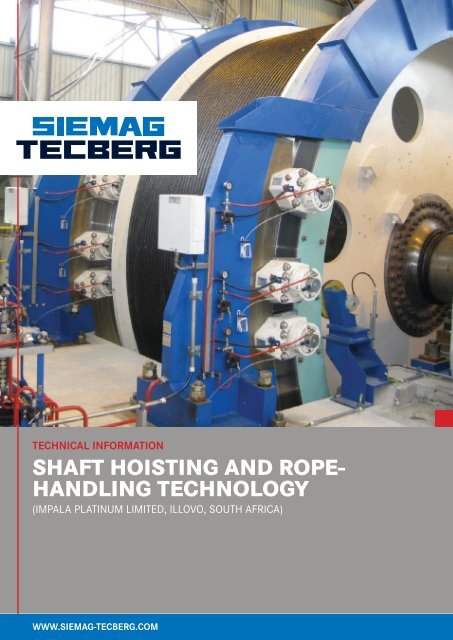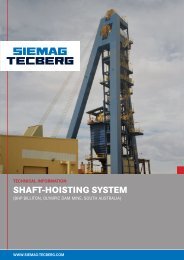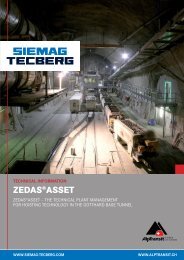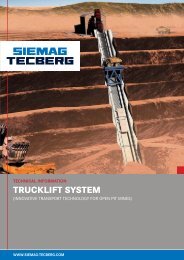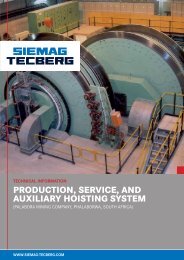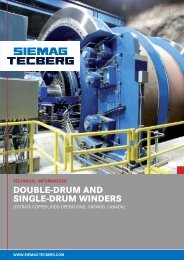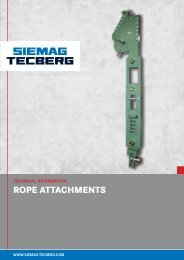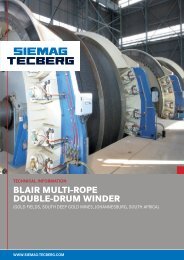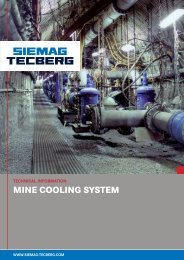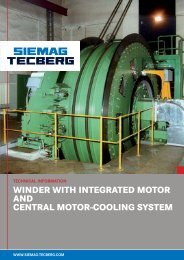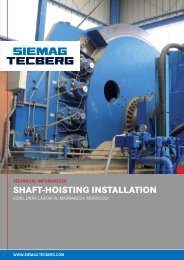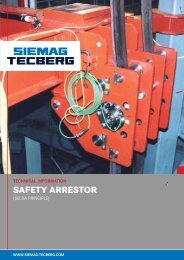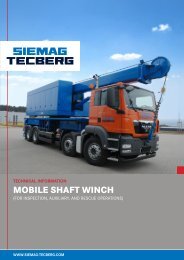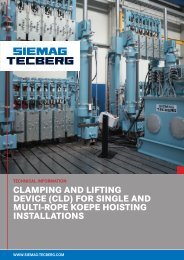SHAFT HOISTING AND ROPE- HANDLING TECHNOLOGY
TI_36_Impala_en.pdf - SIEMAG TECBERG
TI_36_Impala_en.pdf - SIEMAG TECBERG
- No tags were found...
Create successful ePaper yourself
Turn your PDF publications into a flip-book with our unique Google optimized e-Paper software.
TECHNICAL INFORMATION<br />
<strong>SHAFT</strong> <strong>HOISTING</strong> <strong>AND</strong> <strong>ROPE</strong>-<br />
H<strong>AND</strong>LING <strong>TECHNOLOGY</strong><br />
(IMPALA PLATINUM LIMITED, ILLOVO, SOUTH AFRICA)<br />
WWW.SIEMAG-TECBERG.COM
TECHNICAL INFORMATION<br />
<strong>SHAFT</strong> <strong>HOISTING</strong> <strong>AND</strong> <strong>ROPE</strong>-<br />
H<strong>AND</strong>LING <strong>TECHNOLOGY</strong><br />
As mining in the platinum belt at Rustenburg in South Africa<br />
progresses, the workings have to push forward to everincreasing<br />
depths. Impala Platinum Limited is no exception<br />
and in 2007 the company decided to construct shaft number<br />
17 to extract ore from a depth of around 2,000 metres.<br />
The sinking of the main shaft had to be started as quickly as<br />
possible, but there was no winder of the required capacity<br />
available at the time. The construction and delivery of a<br />
new winder would have taken too long and wrecked the<br />
customer‘s tight schedule.<br />
At this time, the customer was discussing with SIEMAG<br />
TECBERG the possibility of finding a suitable winder for the<br />
new shaft among the machinery decommissioned following<br />
the phasing-out of coal mining in Germany. The Koepe<br />
winder installed at the Goettelborn mine seemed to meet<br />
the requirements for mining ore at Shaft 17. Since a second<br />
hoisting system with a second Koepe winder was planned<br />
for transporting material and personnel, the solution was<br />
adopted of using the two winders for the final mine in order<br />
to sink the main shaft.<br />
SKIP TRANSPORT DURING SINKING OPERATIONS<br />
The twin-drum machines normally used for shaft sinking have<br />
a resetting (clutch) device to allow two skips to be hoisted<br />
and lowered alternately and to load and unload them at the<br />
same time as the distance to the foot of the shaft steadily<br />
increases. Koepe winders are unsuitable for operations of<br />
this kind, but when suitably converted, can work with one<br />
skip. It was therefore decided to dismantle the machine at<br />
the Goettelborn shaft and transport it to South Africa. It<br />
was also decided to replace the electrical control system<br />
at the same time and construct a new drum locally to cope<br />
with both the shaft-sinking operations and the subsequent<br />
mining operations. The high constricting pressures from the<br />
five-layer coiling of the loaded rope made drums with extrathick<br />
sheet casing necessary for both machines.<br />
In the case of Impala 17, single-kibble operation was<br />
sufficient in the initial shaft-sinking phase and the converted<br />
Goettelborn winder proved suitable for the purpose. This<br />
allowed work on the shaft to be started early and the second<br />
kibble went into operation when the service winder was<br />
completed to allow enough material to be hoisted as the<br />
travel distance increased. As opposed to conventional shaftsinking<br />
winders, this solution allows kibbles to be hoisted<br />
6-Rope Koepe production winder (formerly at Goettelborn shaft, Germany), currently modified as sinking winder
singly and independently of one another. On conclusion of<br />
the sinking operations, the two machines will be cleaned, the<br />
ropes removed, and then converted for Koepe-type hoisting<br />
by bolting metal blocks in a ring around the drum to create<br />
trapezoid grooves, and to fit the usual two-part friction-pulley<br />
liner blocks for six-rope hoisting. This conversion work has<br />
already been rehearsed in our workshop so that the actual<br />
work on-site can be completed as quickly as possible.<br />
SIEMAG TECBERG was able to offer this solution as tried<br />
and tested technology because several conversions of this<br />
type have already been carried out in similar cases and the<br />
concept approved as sound and effective. In addition to<br />
the two winding machines, SIEMAG TECBERG will also be<br />
supplying the rope sheaves for the mining operations. The<br />
great depth makes the stress on the ropes very high, which<br />
means that the machines and the rope sheaves had to be<br />
specially dimensioned.<br />
These two factors – the depth and the high rope weights –<br />
are also the reason why Impala has purchased a large<br />
SIEMAG TECBERG friction winch. This pulley makes it<br />
possible to raise or lower all six ropes, each measuring<br />
2000 metres, at the same time in less than three hours.<br />
The tractive forces occurring can be as high as 180 tonnes.<br />
Like most others, the friction winch is mounted on a chassis<br />
and can therefore be moved to different positions. For this<br />
reason, it is suitable not only for installing and changing the<br />
ropes in the two hoisting systems at Shaft 17, but also for<br />
those two at Shaft 16. (For more details on friction winches,<br />
see our separate technical information).<br />
Clamping and lifting devices are also being installed<br />
at both shafts. These are a fast and reliable means of<br />
relieving the weight in order to carry out frequently<br />
recurring work on the ropes. The two clamping and lifting<br />
devices for shaft 16 were designed for an operating load<br />
of 170 tonnes and are therefore suitable for hoisting a<br />
full conveyance from the very deepest position. A third<br />
clamping and lifting device is intended for handling one<br />
tail rope in each case. Together with the necessary<br />
rope reelers, messenger winches, deflection sheaves<br />
and other aids, SIEMAG TECBERG has developed and<br />
supplied complete solutions for rope-handling and<br />
changing specifically for the customer‘s needs. (For<br />
more details on clamping and lifting devices, see our<br />
separate technical information).<br />
The rope-handling systems selected have made it possible<br />
to avoid processes which are normally time-consuming<br />
and dangerous, as well as the over-dimensioning of the<br />
drive engines for the hoisting machinery which would<br />
otherwise have been necessary to hold the abovementioned<br />
loads.<br />
With its machinery and rope sheaves as well as its<br />
handling devices and other equipment, SIEMAG TECBERG<br />
has again proven its outstanding expertise in the field<br />
of shaft hoisting by again extending the limitations of<br />
previously realised plant and machinery.<br />
6-Rope Koepe service winder, currently modified as sinking winder
1 to 6-Rope friction winch, max. traction force 1,800 kN<br />
2 x 4-Rope clamping and lifting device, double-sided, max. rope load 1,700 kN
TECHNICAL DATA<br />
KOEPE ROCK <strong>HOISTING</strong> DUTY<br />
Winding data<br />
Type of winding<br />
Type of conveyance<br />
Type of shaft<br />
Monthly winding capacity<br />
Winding capacity<br />
production<br />
skip/skip<br />
vertical<br />
260,000mt/m<br />
700mt/h<br />
Winding distance 1,922m<br />
Payload<br />
Maximum unbalanced load<br />
Maximum suspended load<br />
(T1+T2)<br />
Number of ropes & Diameter<br />
Winding speed<br />
33mt<br />
330kN<br />
3,525kN<br />
6 x 50mm<br />
18m/s<br />
KOEPE MAN <strong>HOISTING</strong> DUTY<br />
Winding data<br />
Type of winding<br />
Type of conveyance<br />
Type of shaft<br />
Winding distance<br />
Payload<br />
Weight of cage, with rope<br />
attachments<br />
Maximum unbalanced load 135 kN<br />
Maximum suspended load 3,560kN<br />
Number of ropes 6<br />
Diameter<br />
50 mm<br />
Winding speed<br />
15 m/s<br />
service<br />
cage/counterweight<br />
vertical<br />
1 872 m<br />
27 t<br />
28.8 t<br />
Friction pulley & drive<br />
Friction pulley & drive<br />
Nominal Diameter<br />
7m<br />
Nominal Diameter<br />
6 m<br />
Pulley / Motor speed<br />
49.1rpm<br />
Pulley / Motor speed<br />
47.8 rpm<br />
Type of motors<br />
overhung AC<br />
Type of motors<br />
overhung AC<br />
Motor power RMS, approx.<br />
1 x 7,500kW<br />
Motor power RMS, approx.<br />
1 x 4,000 kW<br />
SINGLE DRUM SINKING DUTY (BOTH MACHINES)<br />
Winding data<br />
Type of winding<br />
sinking<br />
Type of conveyance<br />
single kibble<br />
Winding distance 1,900m<br />
Payload<br />
16mt<br />
Weight of kibble<br />
7.8mt<br />
Maximum unbalanced load 463kN<br />
Maximum suspended load 463kN<br />
Number of ropes 1<br />
Diameter<br />
51mm<br />
Winding speed<br />
15m/s<br />
Drum & drive<br />
Diameter, centreline of rope,<br />
approx.<br />
Coiling width, approx.<br />
Drum / Motor speed<br />
Type of motors<br />
6.7 / 5.85m<br />
1.85 / 2m<br />
40.9 / 47.8rpm<br />
overhung AC<br />
Rope reelers, drum diameter max. 3.0 m<br />
Installed motor power RMS<br />
7,500 / 4,000kW


